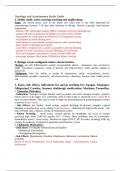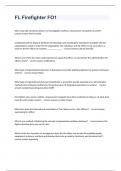Oncology and Autoimmune Study Guide
1. Define nadir, know nursing teaching and implications.
Nadir- the lowest point, such as the blood cell count after it has been depressed by
chemotherapy between 7-10 days after initiation of therapy. Period of greatest bone marrow
suppression.
- monitor CBC (neutrophil, platelet, RBC) in patients receiving chemotherapy
- patient will need a transfusion of platelets if count is below 20,000
- teach patient to avoid aspirin or NSAIDs b/c of antiplatelet activity
- teach patient to avoid blowing nose
- teach patient to count number of pads/tampons when menstruating
- place patient on bleeding precautions
- avoid IM or venipunctures as much as possible to prevent bleeding
- monitor for fever, sore throat, unusual bleeding, s/s of infection
- Place on neutropenic precautions if count is below 1000 cells
- encourage adequate fluid intake (2000ml) for kidney function
2. Benign versus malignant tumor characteristics
•Benign: are well differentiated; usually -encapsulated; absent – metastasis; rare- recurrence;
slight- vascularity; expansive- mode of growth; cell characteristics- fairly normal, similar to
parent cell
•Malignant: have the ability to invade & metastasize; rarely- encapsulated; poorly-
differentiated; possible- recurrence; cell characteristics- abnormal, become more unlike parent
cell.
3. Know side effects, indications for and pt teaching for: Epogen, Nuepogen,
Allopurinol, Casodex, Sinemet, cholinergic medications, Mestinon, Tamoxifen
1. Tamoxifen (Nolvadex):
• Indications: Estrogen receptor blocker used in women who have estrogen receptor –positive
breast cancer of all stages. It is commonly used in early-stage or advanced breast cancer & to
treat recurrent disease. May also be used in high-risk premenopausal & postmenopausal women
to prevent breast cancer.
• Side Effects: hot flashes; mood swings; vaginal discharge & dryness; irregular vaginal
bleeding or spotting may occur; edema; hypercalcemia; ↑ cholesterol & triglyceride levels; ↑ the
risks of blood clots, cataracts, stroke, & endometrial cancer
• Patient Teaching: ↓ visual acuity, corneal opacity, & retinopathy can occur in women
receiving high doses (240-320 mg/day for > 17mo). These problems may be irreversible.
Immediately report ↓ visual acuity. Monitor for signs of DVT, PE, & stroke, including SOB, leg
cramps, & weakness. Treatment is generally prescribed for 5 years.
2. Cholinergic Medications:
• Indications: For bladder retention (flaccid bladder)
• Bethanecol (Urecholine)
• Neostigmine (Prostigmine)
• Side Effects: Hypotension, Diarrhea, Diaphoresis, Salivation, Lacrimation, Muscle
weakness
Beware if Hx Of: Hypotension, Use of andrenergic drugs --> bronchospasm, Cardiac
dysfunction
,•Patient Teaching: ask doctor before taking any other medications or OTC meds.
Cholinergic Overdose:
•S/S: SLUD
Salivation
Lacrimation
Urination
Defecation
Weakness (SLUD like SLUG)
3. Sinemet (Carbidopa/Levodopa): Dopaminergics- Dopamine Precursor- Parkinson’s Disease
• Indications: Levodopa is converted to dopamine (DA) in the basal ganglia; allows more
dopamine to reach the brain; Levodopa w/ Carbidopa is needed b/c carbidopa prevents the early
break down of Levodopa by the brain. Relieves symptoms: bradykinesia, tremor & rigidity
• Side Effects: Dyskinesia; uncontrolled movement of face, eyelids, mouth, tongue, arms, hands,
or legs; mental changes; palpitations; severe N/V; difficulty urinating; hypomobility (inability to
rise from chair, to speak, or to walk); orthostatic hypotension
• Patient Teaching:
- Report any uncontrolled movement of face, eyelids, mouth, tongue, arms, hands, or legs;
mental changes; palpitations; severe N/V; & difficulty urinating
- Effects may be delayed for several weeks to months
- Prolonged use can result in dyskinesias & “on/off” periods when the medication will
unpredictably start or stop working
- Must avoid foods high in protein and B6- effects absorption of levodopa
- May discolor urine or sweat a dark color
- Report signs of hypomobility (inability to rise from chair, to speak, or to walk)
- Take meds w/food if N/V occurs
- Change positions slowly to minimize orthostatic hypotension
- Avoid alcohol
- Don’t abruptly stop taking medication
4. Casodex (bicalutamide): Androgen Receptor Blockers
• Indications: Used for the treatment of prostate cancer. It blocks the action of testosterone by
competing w/ receptor sites. Limits amount of circulating androgens (↓ testosterone); shrinks
tumor. ↓ PSA level
• Side Effects: Loss of libido, erectile dysfunction, hot flashes, breast pain/edema, gynecomastia,
weight gain, weakened bones & muscles, impotence, ↓ mood/energy, N/V
• Patient Teaching:
- Take medication daily
- will need to take medication indefinitely
- Report side effects
5. Neupogen (filgrastim): Colony stimulating factors
• Indications: Used to reduce the duration of chemotherapy-induced neutropenia &
prophylactically to prevent neutropenia. Increase the growth of WBC in bone marrow
• Side Effects: bone pain (initial tx), pain at injection site, fever, headache, muscle aches,
flushing, anorexia, cough, sore throat, N/V, rash, edema
• Patient Teaching:
- Report s/s of infection; excessive fatigue, bleeding
- Can take Tylenol or opioids for bone pain
, - Get plenty of rest
6. Allopurinol (Zyloprim):
• Indications: Used to ↑ the excretion of purines (Tumor Lysis Syndrome) & prevent TLS,
↓serum uric acid levels (r/t antineoplastic meds for leukemia and lymphoma)
• Side Effects: agranulocytosis, aplastic anemia, exfoliative dermatitis, Stevens-Johnson
syndrome
• Patient Teaching:
- Talk with doctor before taking OTC med
- Report side effects
- Drink plenty of fluids
7. Epogen (epoetin alfa): Colony stimulating factors
• Indications: Anemia due to chemotherapy, tell bone marrow to make RBC
• Side Effects: Seizures, HTN, Pain at injection site, fever, headache, muscle aches, flushing,
anorexia, cough, sore throat, N/V, rash, edema
• Patient Teaching:
- Report s/s of infection; excessive fatigue; bleeding
- Can take Tylenol or opioids for bone pain
- Get plenty of rest
8. Mestinon (pyridostigmine):
• Indications: Relieve muscle weakness associated with Myasthenia Gravis by blocking
acetylcholine breakdown at the neuromuscular junction
• Side Effects: abdominal cramps, N/V, diarrhea, miosis (constricted pupils), hypotension,
dizziness, ↑ bronchial secretions, ↑tearing & salivation, ↑ perspiration, bronchospasm, wheezing,
bradycardia
• Patient Teaching:
- Take medication on time to maintain therapeutic blood level
- Take meds w/ small amount of food to prevent GI upset
- Eat big meal 45-60 mins after taking meds to ↓ risk for aspiration
- Wear Medic-Alert bracelet
- Medication is a lifelong therapy
4. Nursing interventions for side effects of chemotherapy or radiation (ie:
nausea, loss of appetite, stomatitis, pain, neutropenia, neutropenia with fever,
fatigue, anemia, thrombocytopenia
Stomatitis: Assess oral mucosa q shift • Encourage nutritional supplements • frequent oral rinses
with baking soda and saline solution • No irritants (tobacco, alcohol, acidic or spicy foods,
mouthwashes, etc.) • Topical anesthetics: viscous lidocaine
Nausea/Vomiting: Eat and drink when not nauseated • Administer antiemetic 1hr before chemo •
Administer scheduled doses of antiemetic 30 mins before meal • Diversional activities • eat
highest amount of protein when not nauseated
Loss of Appetite (anorexia): Monitor weight daily • Encourage small, frequent high protein- high
calorie meals • Serve food in pleasant environment • Provide preferred foods (cultural
preferences, sweets, pleasure foods) • don’t drink w/meals
Fatigue: Asses for reversible causes of fatigue (anemia, depression, anxiety, insomnia,
dehydration, infection, or hypothyroidism) & address them as indicated • Reassure patient that





